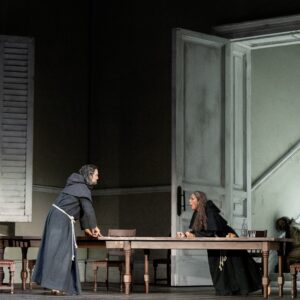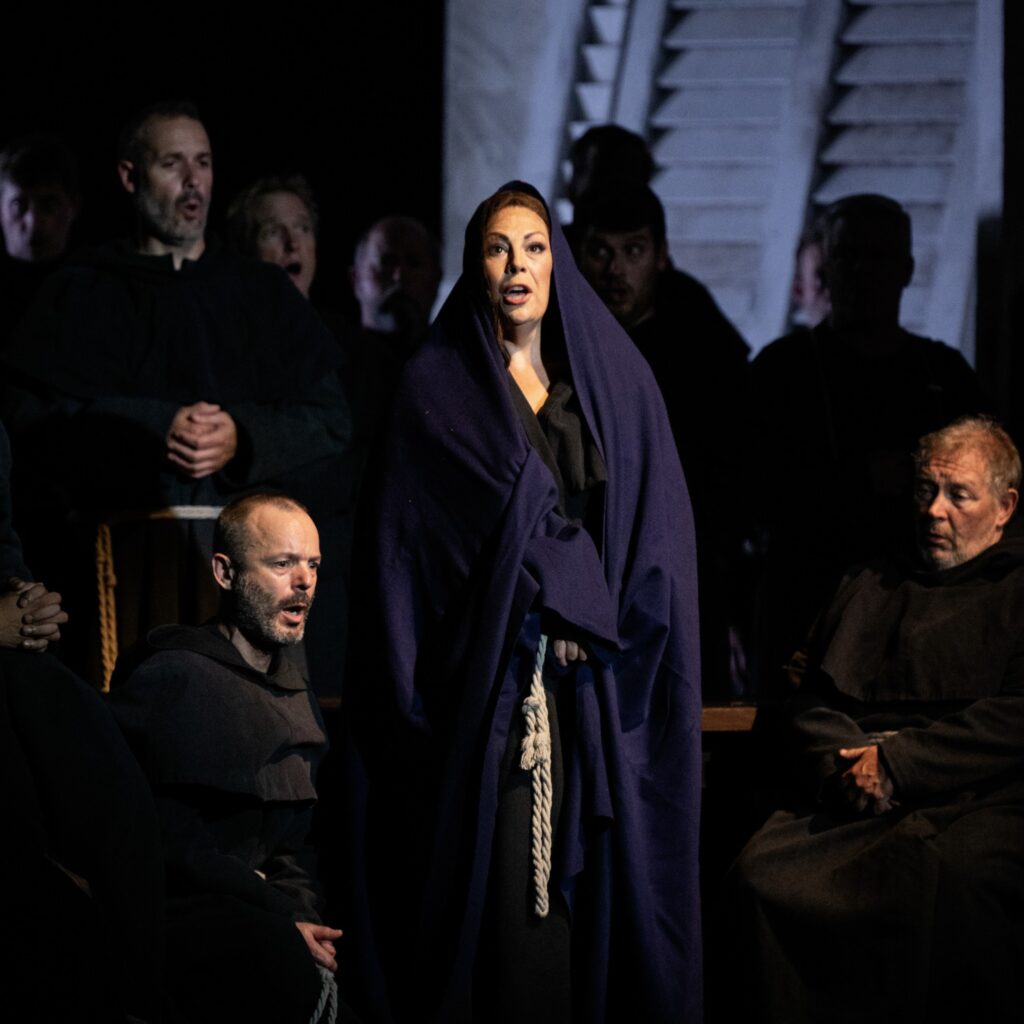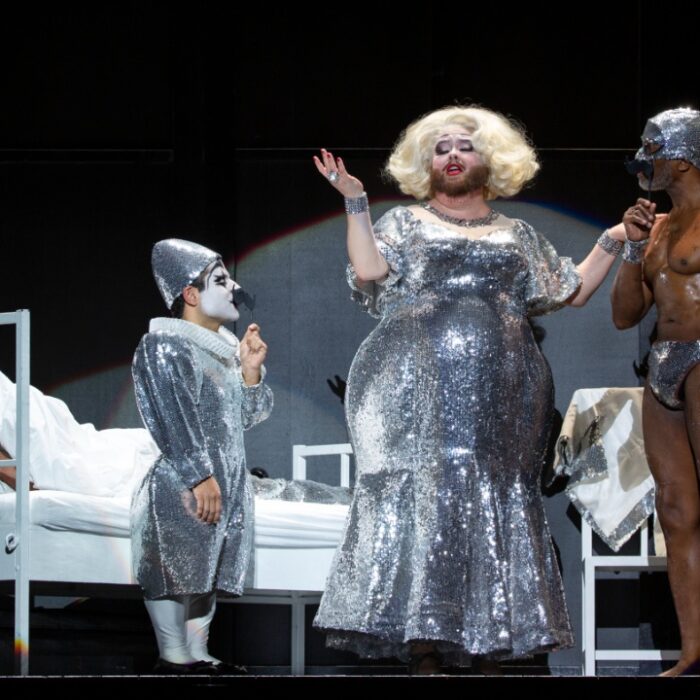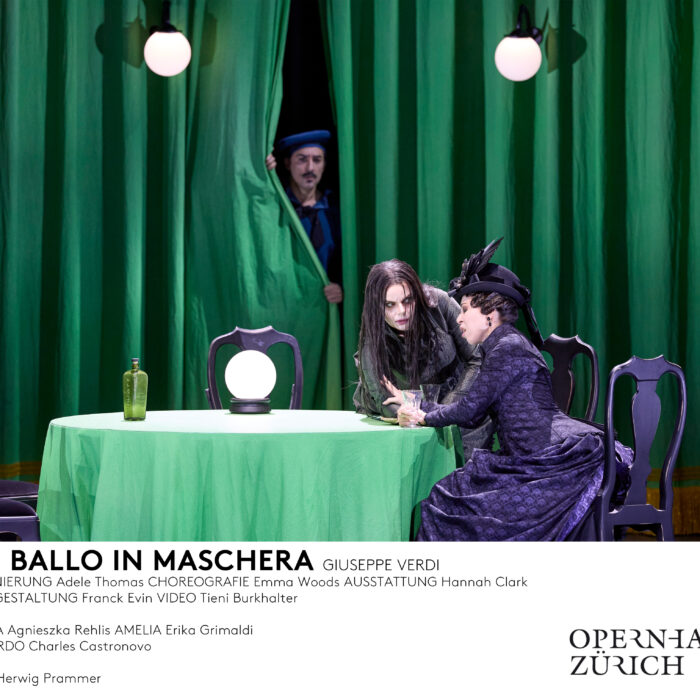
Royal Opera House 2023-24 Review: La Forza del Destino
By Mike Hardy(Credit: Royal Opera)
I suppose anything with “Destiny” in the title will always be a bit profound. In fact, “La Forza” is about as profound and gloomy, if not downright dark as it gets, even by Verdi’s standards. At around four and a half hours, it’s also his longest work.
It’s a story of love, death, and revenge. Mainly revenge. Lots of revenge. And vengeance. And revengefulness. And vengefulness. You get the picture.
Questionable Storytelling
It’s a rather incredulous tale of how Alvaro, son of a Spanish nobleman, accidentaly kills the father of his paramour, Leonora, in a confrontation which sees the son and Leonora’s brother, Carlo, vowing to avenge the death. Carlo then pursues the pair, who flee the scene separately, for the next however many years, in order to exact his revenge. During which time, Leonora takes up residence in a cave as the ultimate persona non grata sacrifice. She is aided and abetted by the brothers of a local monastery. Alvaro runs off to war with a wish to die, only to become a Captain and war hero before he too, finally ends up seeking sanctuary in a monastery. The revenge obsessed Carlo actually interacts with BOTH of his intended victims without first realizing their true identities, and initially befriends Alvaro with whom he ends up fighting alongside in the war.
If this tale doesn’t test one’s bounds of credulity sufficiently, then the choreography of Otto Pichler and Klevis Elmazaj should seal it. They present a rather bizarre cornucopia of characters and dance routines in the intermittent crowd scenes that appear in Scene one of Act two, and in Scene two of Act three. Ostensibly set in 18th Century Spain, the “Carnival” scenes are a weird conglomeration of 20th Century West End musical and influences from the movies “Oh what a lovely war” and “Cabaret.” Key characters are in bright, garish colors, a powder blue suit for one, a maroon trouser suit for another, and an assorted gathering of attendees in suits. Evening and even casual attire are all clearly modern and contemporary. Dance troupes are homoerotic, cavorting between young men, “good-time” girls dressed in shimmering and sparkling costumes similar to a Christmas chocolate assortment wrapper-style dress. There is a line of men with tall green hats jumping and convincing like they were going to perform some excerpt from “Riverdance.”

Royal Opera House
Vocal Abundance
Opera, no matter how grand, is all about the music, voices and credibility in story telling. While the story telling of the tale itself was very thin on the ground, the vocal and musical talent was very much in abundance. Moreover, where the plot and story may be devoid of any credibility, the acting performances of the main characters was more than convincing.
Sondra Radvanovsky as Leonora gets to show off her amazing instrument, positively bouncing her piercing soprano from every architectural surface of the house. Her lavish tones were caressive and affective. Her “Me pellegrina ed orfana” in the first act was imbued with seemingly genuine anguish. Her “La Vergine degli Angeli,” accompanied by the Chorus of the Royal Opera House was particularly evocative. Her exquisitely floating pianissimos in “Pace, Pace Mio Dio” were breathtaking. This was not only a remarkably youthful voice, but a remarkably youthful performance demonstrating agility, dexterity, and controlled mobility. She received several cheers and rounds of applause throughout the evening.
Brian Jagde is a big guy with a big voice to match. While singing the role of Don Alvaro, he suffered the misfortune of having been stricken by a debilitating illness during this run, a serious cold and infection requiring copious amounts of medication and antibiotics. Not that one would know that from this performance. Having famously, initially, trained as a baritone, he has a beautifully rich and resonant deep tone which infuses much of his lower and middle registers. This often makes it difficult to separate him, vocally, from any accompanying baritone. Only when Jagde ascends into head voice does his wonderful, bright, and polished tenor flow forth with an illustrious ping, trumpeting high notes and more than enough volume to circumvent the most ardent of orchestras. Not that he is all about the expanse. His “O tu che in seno agli angeli” was most impassioned and nuanced. His “Solenne in quest’ora” was beautifully measured and genuinely heart rending. He is unquestionably one of the leading exponents of roles like this, possessing great stage presence infused with a charisma that marks him as the quintessential heroic tenor; and in this case a proper swashbuckling one at that! As my wife, who was accompanying me for the performance, commented: “If he sounds like that when he’s ill, what is he like when he’s well?”
Canadian baritone Étienne Dupuis as Don Carlo was a replacement for the indisposed Igor Golovatenko. During this performance, and with no disrespect to the latter, one must have compelled the powers that be at the Royal Opera House to wonder why he wasn’t their natural choice in the first place. Dupuis possesses a beautiful, dark timbre with a rich, velvety baritone. At key points, his voice blended wonderfully well with, and not hugely dissimilar to, Jagde’s lower register, he turned into a magisterial performance of some quality. His duet with Alvaro, “Solenne in quest’ora” was instrumental in making it evocative. His “Son Pereda, son ricco d’onore” was delivered with much entrancement and panache. His “Urna fatale del mio destino,” on discovering the true identity of his stricken fellow soldier and friend, was convincing enough and his further interactions with Alvaro leading up to their final duel were utterly mezmerising on account of both men’s ardor.
But the vocal splendors in this performance weren’t just restricted to the key roles. Russian bass Evgeny Stavinsky sang the role of Padre Guardiano, the Father Superior. His gorgeous, treacly bass positively exuded intensity.
Rodion Pogossov possesses a fine baritone but shone most with his acting skills, playing a curmudgeonly Fra Melitone. He hammed it up a la Ebenezer Scrooge style, dispensing cutting epithets along with the gruel to starving beggars.
Russian mezzo-soprano Vasilisa Berzhanskaya gave a dazzling, showgirl and chorus lead performance as the young gypsy Preziosilla. She was first in the afore-mentioned maroon trouser suit and then changed into a shimmering green “Genie of the lamp-style” attire. She was vocally secure with a pleasing mezzo. Her role here, if not that of the whole dancing troupe/carnival ensemble, seems at curious odds and irrelevant to the plot.
Thomas D Hopkinson as Alcalde, possesses a magnificent bass instrument worthy of something far more prominent than his brief appearance here.
James Creswell puts in a solid performance as the ill-fated Marquis of Calatrava stentorian in voice and tangibly dripping in loathing for his daughter’s admirer. He was instrumental in creating the tense atmosphere that persisted and pervaded the whole performance.
Comprimario tenor Carlo Bosi provides a little, much needed light relief as Mastro Trabuco, an itinerant peddler whose light, lyric tenor was employed to comedic effect.
Conductor Mark Elder led with such aplomb and assuredness that he conveyed the impression that he could easily hold the reins here in his sleep. His minimalist, often barely perceptible hand gestures elicited such exquisite sounds from this magnificent orchestra full of heart-rending strings, beautifully floated woodwind and a whole plethora of transcending combinations and solos. Elder’s control of both orchestra and performers was majestic and seemingly effortless.
Struggling for Ideas
Minimalism also extended to the staging and scenery. Designer Christian Schmidt seemingly struggled for ideas with a stage that has to depict the home of Leonora’s family, a monastery, a military camp, and a couple of carnivals. But then, given this opera spans across vastly differing geographical locations and expansive time periods, it was always going to be a struggle to produce a convincing set. Although it did serve to heighten the sense of oppressiveness and claustrophobia well.
Additionally, and along with the direction of Christof Loy, there were some visually impressive accomplishments. The cine-projected scenes of the tragedy at hand, reinforced by black and white close-ups of a horror-stricken Leonora, projected full height onto the stage at key times, served to amplify the tension. The carnival and dance routines, although seemingly out of place, mildly perplexing and superfluous, were none the less entertaining, hilariously so, at times. In several early scenes, the performers were motionless at the curtain rise, like mannequins, before coming to life as in some movie flashback scene making for a most effective and impactive statement.
Olaf Winter was more imaginative with the lighting, highlighting and intensifying key moments with suitable spots, and employing suitable keys and fills to create emotive and moody shadow play.
Frequently lauded as a Verdi masterpiece, and musically it most definitely is, one cannot reconcile themselves with the utterly pervasive bleakness that Verdi elected to pursue here. Of course, opera rarely has happy endings and the frequent tragedies that occur within them are often comprehensible, even if they are sad and undesirable. But one cannot fathom why the composer made Carlo so resolute, so unmovable, so unforgiving and unwilling to relent with his vengefulness, even under the most ardent entreaties made by Alvero and presumably his own sister in the final act, in his pursuance of their demise.
Perhaps this is coming from a die-hard romantic. Perhaps it’s also why Verdi added the song and dance routines at a later stage to lighten the mood, having become aware of the austerity and all-encompassing blackness of his tale.
If a creation can sometimes, genuinely, be greater than the sum of its parts, then I would seriously suggest this performance.



